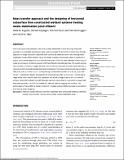Mass transfer approach and the designing of horizontal subsurface flow constructed wetland systems treating waste stabilisation pond effluent

View/
Date
2018-11-29Author
Rugaika, Anita
Kajunguri, Damian
Deun, Rob
Bruggen, Bart
Njau, Karoli
Metadata
Show full item recordAbstract
Pilot-scale constructed wetlands (CWs) that allowed wastewater to flow with high interstitial velocities in a controlled environment were used to evaluate the possibility of using mass transfer approach to design horizontal subsurface flow constructed wetlands (HSSF-CWs) treating waste stabilisation ponds (WSPs) effluent. Since CW design considers temperature which is irrelevant in tropics, mass transfer approach could improve the design. HSSF-CWs were operated in batch recycle mode as continuous stirred tank reactors (CSTR) at different interstitial velocities. The overall removal rate constants of chemical oxygen demand (COD) at various interstitial velocities were evaluated in mesocosms that received pretreated domestic wastewater. The mean overall removal rate constants were 0.43, 0.69, 0.74 and 0.73 d−1 corresponding to interstitial velocities of 15.43, 36, 56.57 and 72 md−1, respectively. Results showed that the interstitial velocities up to 36 md−1 represented a range where mass transfer effect was significant and, above it, insignificant to the COD removal process. Since WSPs effluent has high flow rates and low organic load, it is possible to induce high interstitial velocities in a HSSF-CW treating this effluent, without clogging and overflow. The performance of these HSSF for tertiary treatment in tropical areas could be improved by considering flow velocity when designing.
